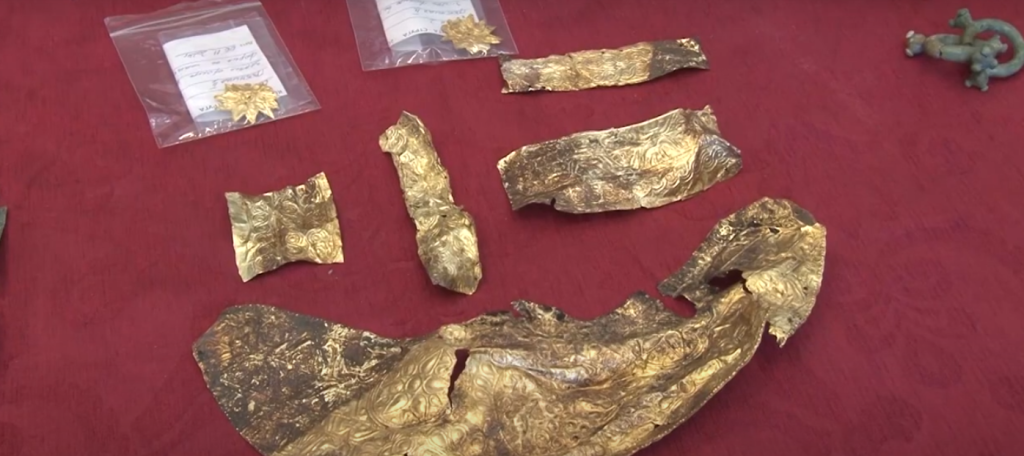In the village of Koroshishta, within the Ohrid region in Macedonia, an extraordinary 6th-century BCE grave was uncovered last week, revealing artifacts that are believed to reflect the ancient Macedonian cultural and religious legacy. Among the 80 discovered items were a bronze helmet, gold rings, silver pins, and unique gold folia adorned with intricate shapes and decorations. Notably, motifs of the Macedonian sun—a powerful symbol in ancient Macedonian culture—were present, sparking enthusiasm among Macedonians.

While local media coverage of the sun motif was muted, potentially due to historical sensitivities with Greece regarding ancient Macedonian heritage, news of this discovery has reverberated across social media, where many Macedonians celebrated it as further affirmation of the Macedonian sun’s significance in the region.
Macedonian Sun Symbol Found Across Key Sites Across the Republic
The newly discovered grave shares similarities with other ancient Macedonian sites, including the rich graves of Trebenishta, which also feature the Macedonian sun, golden death masks, and elaborate jewelry from the same period, as well as those in Aigai (modern-day Greece). In fact, wine drinking cups adorned with the Macedonian sun were found in Ohrid, dating back to the time of Philip II of Macedonia, alongside royal shields discovered near Bonce. This symbol of the Macedonian sun has been uncovered in numerous locations across the modern Republic of Macedonia, further affirming its role in ancient Macedonian cultural development. This of course draws the ire of Greece, where the discovery of the symbol in the Republic is often viewed as a direct challenge to its narrative surrounding the region’s historical identity.
The prominence of the sun symbol among the grave goods underscores its importance in ancient Macedonian culture. Dr. Nade Proeva, a historian of ancient Macedonia, has emphasised that this symbol reflects a Macedonian sun cult that paralleled the Greek worship of Helios. References by Herodotus and later Maximus of Tyre mention Macedonian reverence for the sun, particularly among the Paeonian tribes, who carried images of their “Paionian Helios” on small discs affixed to long poles. These same discs have been discovered in the Macedonian tombs in Aigai.

Macedonian Tribe at the Early Stages of Forming Ancient Macedonian Identity
Local archaeologists attribute the tomb to the Enchelei, an ancient Macedonian tribe, based on the research of Dr. Proeva. This tribe inhabited the Ohrid-Struga region and founded cities like Lichnid (modern-day Ohrid) and Enhalon (present-day Struga). Although distinct, the Enchelei were part of a larger collective known as the Dasareti, who historical sources place north of Epirus. Dr. Proeva’s work also highlights the connection between the Enchelei and the Brigians, an ancient Balkan people, suggesting they played a vital role in forming the ancient Macedonian ethnic identity.
Archeologist Calls Find Unparalleled
Reflecting on the importance of the find, archaeologist Pero Ardzhanliev stated, “This discovery, monumental in nature and unparalleled in the Balkan region, stands as a testament to the power and prestige of the ancient Enchelei elite.” Ardzhanliev confirmed that while there was no golden mask or jar of coins as some rumors suggested, the tomb contained a remarkable array of precious items, surpassing those of other known Archaic necropolises.

With the graves now secured, the newly uncovered artifacts will soon be displayed at the Archaeological Museum in Skopje.



